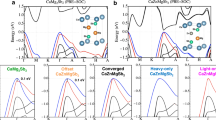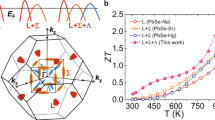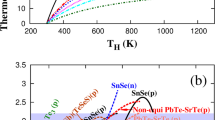Abstract
Thermoelectric generators, which directly convert heat into electricity, have long been relegated to use in space-based or other niche applications, but are now being actively considered for a variety of practical waste heat recovery systems—such as the conversion of car exhaust heat into electricity. Although these devices can be very reliable and compact, the thermoelectric materials themselves are relatively inefficient: to facilitate widespread application, it will be desirable to identify or develop materials that have an intensive thermoelectric materials figure of merit, zT, above 1.5 (ref. 1). Many different concepts have been used in the search for new materials with high thermoelectric efficiency, such as the use of nanostructuring to reduce phonon thermal conductivity2,3,4, which has led to the investigation of a variety of complex material systems5. In this vein, it is well known6,7 that a high valley degeneracy (typically ≤6 for known thermoelectrics) in the electronic bands is conducive to high zT, and this in turn has stimulated attempts to engineer such degeneracy by adopting low-dimensional nanostructures8,9,10. Here we demonstrate that it is possible to direct the convergence of many valleys in a bulk material by tuning the doping and composition. By this route, we achieve a convergence of at least 12 valleys in doped PbTe1 − xSe x alloys, leading to an extraordinary zT value of 1.8 at about 850 kelvin. Band engineering to converge the valence (or conduction) bands to achieve high valley degeneracy should be a general strategy in the search for and improvement of bulk thermoelectric materials, because it simultaneously leads to a high Seebeck coefficient and high electrical conductivity.
This is a preview of subscription content, access via your institution
Access options
Subscribe to this journal
Receive 51 print issues and online access
$199.00 per year
only $3.90 per issue
Buy this article
- Purchase on Springer Link
- Instant access to full article PDF
Prices may be subject to local taxes which are calculated during checkout




Similar content being viewed by others
References
Bell, L. E. Cooling, heating, generating power, and recovering waste heat with thermoelectric systems. Science 321, 1457–1461 (2008)
Kanatzidis, M. G. Nanostructured thermoelectrics: the new paradigm? Chem. Mater. 22, 648–659 (2010)
Poudeu, P. F. P. et al. High thermoelectric figure of merit and nanostructuring in bulk p-type Na1-xPbmSbyTem+2 . Angew. Chem. Int. Edn 45, 3835–3839 (2006)
Pei, Y., Lensch-Falk, J., Toberer, E. S., Medlin, D. L. & Snyder, G. J. High thermoelectric performance in PbTe due to large nanoscale Ag2Te precipitates and La doping. Adv. Funct. Mater. 21, 241–249 (2011)
Snyder, G. J. & Toberer, E. S. Complex thermoelectric materials. Nature Mater. 7, 105–114 (2008)
Mahan, G. D. in Solid State Physics (eds Ehrenreich, H. & Spaepen, F. ) Vol. 51, 81–157 (Academic, 1998)
Goldsmid, H. J. Thermoelectric Refrigeration (Plenum, 1964)
Dresselhaus, M. S. et al. New directions for low-dimensional thermoelectric materials. Adv. Mater. 19, 1043–1053 (2007)
Koga, T., Sun, X., Cronin, S. & Dresselhaus, M. Carrier pocket engineering to design superior thermoelectric materials using GaAs/AlAs superlattices. Appl. Phys. Lett. 73, 2950–2952 (1998)
Rabina, O., Lin, Y. & Dresselhaus, M. Anomalously high thermoelectric figure of merit in Bi1-xSbx nanowires by carrier pocket alignment. Appl. Phys. Lett. 79, 81–83 (2001)
Heremans, J. et al. Enhancement of thermoelectric efficiency in PbTe by distortion of the electronic density of states. Science 321, 554–557 (2008)
Slack, G. A. in CRC Handbook of Thermoelectrics Ch. 34 (ed. Rowe, D. M. ) 406–440 (CRC, 1995)
DiSalvo, F. J. Thermoelectric cooling and power generation. Science 285, 703–706 (1999)
Ravich, Y. I., Efimova, B. A. & Smirnov, I. A. Semiconducting Lead Chalcogenides (Plenum, 1970)
Nimtz, G. & Schlicht, B. Narrow-gap lead salts. Springer Tracts Mod. Phys. 98, 27–40 (1983)
Ravich, Y. I. in Lead Chalcogenides: Physics and Applications (ed. Khokhlov, D. ) 1–34 (Taylor and Francis, 2003)
Ashcroft, N. W. & Mermin, N. D. Solid State Physics 570 (Brooks Cole, 1976)
Bilc, D. et al. Resonant states in the electronic structure of the high performance thermoelectrics AgPbmSbTe2+m: the role of Ag-Sb microstructures. Phys. Rev. Lett. 93, 146403 (2004)
Tauber, R. N., Machonis, A. A. & Cadoff, I. B. Thermal and optical energy gaps in PbTe. J. Appl. Phys. 37, 4855–4860 (1966)
Strauss, A. J. Metallurgical and electronic properties of Pb1-xSnxTe, Pb1-xSnxSe, and other IV–VI alloys. Trans. Metall. Soc. AIME 242, 354–365 (1968)
Fritts, R. W. in Thermoelectric Materials and Devices (eds Cadoff, I. B. & Miller, E. ) 143–162 (Reinhold, 1960)
Androulakis, J. et al. Thermoelectric enhancement in PbTe with K or Na codoping from tuning the interaction of the light- and heavy-hole valence bands. Phys. Rev. B 82, 115209 (2010)
Pei, Y., LaLonde, A., Iwanaga, S. & Snyder, G. J. High thermoelectric figure of merit in heavy-hole dominated PbTe. Energy Environ. Sci. 10.1039/c0ee00456a (2011)
Kudman, I. Thermoelectric properties of p-type PbTe-PbSe alloys. J. Mater. Sci. 7, 1027–1029 (1972)
Chernik, I. A., Kaidanov, V. I., Vinogradova, M. I. & Kolomoets, N. V. Investigation of the valence band of lead telluride using transport phenomena. Sov. Phys. Semicond. 2, 645–651 (1968)
Lyden, H. A. Temperature dependence of the effective masses in PbTe. Phys. Rev. A 135, A514–A521 (1964)
Ravich, Y. I., Efimova, B. A. & Tamarche, V. I. Scattering of current carriers and transport phenomena in lead chalcogenides. 1. Theory. Phys. Status Solidi B 43, 11–33 (1971)
Crocker, A. J. & Rogers, L. M. Valence band structure of PbTe. J. Phys. Coll. 29, 129–132 (1968)
Alekseeva, G. T., Efimova, B., Ostrovsk, L. M., Serebrya, O. S. & Tsypin, M. Thermal conductivity of solid solutions based on lead telluride. Sov. Phys. Semicond. 4, 1122–1125 (1971)
Blachnik, R. & Igel, R. Thermodynamic properties of iv–vi-compounds: leadchalcogenides. Z. Naturforsch. B 29, 625–629 (1974)
Acknowledgements
This work was supported by NASA-JPL and the DARPA Nano Materials programme; the work at SIC-CAS was supported by CAS. We thank J.-P. Fleurial, S. Bux, D. Zoltan and F. Harris for measurements of transport properties at NASA’s Jet Propulsion Laboratory and at ZT Plus Inc.
Author information
Authors and Affiliations
Contributions
Y.P. synthesized the samples, measured the high temperature properties and developed the three-band model; X.S. and L.C. measured the low temperature Hall coefficient and confirmed the high temperature transport properties on some of the samples. A.L. performed the hot pressing; Y.P., X.S., A.L., H.W., L.C. and G.J.S. analysed the experimental data; and Y.P. and G.J.S. wrote and edited the manuscript.
Corresponding author
Ethics declarations
Competing interests
The authors declare no competing financial interests.
Supplementary information
Supplementary Information
The file contains Supplementary Text, Supplementary Figures 1-3 with legends and additional references. (PDF 443 kb)
Rights and permissions
About this article
Cite this article
Pei, Y., Shi, X., LaLonde, A. et al. Convergence of electronic bands for high performance bulk thermoelectrics. Nature 473, 66–69 (2011). https://doi.org/10.1038/nature09996
Received:
Accepted:
Published:
Issue Date:
DOI: https://doi.org/10.1038/nature09996
This article is cited by
-
Anomalous enhancement of thermoelectric power factor in multiple two-dimensional electron gas system
Nature Communications (2024)
-
Efficient first-principles electronic transport approach to complex band structure materials: the case of n-type Mg3Sb2
npj Computational Materials (2024)
-
Germanium-telluride-based thermoelectrics
Nature Reviews Electrical Engineering (2024)
-
Full-landscape selection rules of electrons and phonons and temperature-induced effects in 2D silicon and germanium allotropes
npj Computational Materials (2024)
-
Elevating energy device potential: exploring optoelectronic and thermoelectric advantages in stable double perovskites K2NaInX6 (X = F, Cl, Br, I) via Ab initio analysis
Journal of Materials Science (2024)
Comments
By submitting a comment you agree to abide by our Terms and Community Guidelines. If you find something abusive or that does not comply with our terms or guidelines please flag it as inappropriate.



